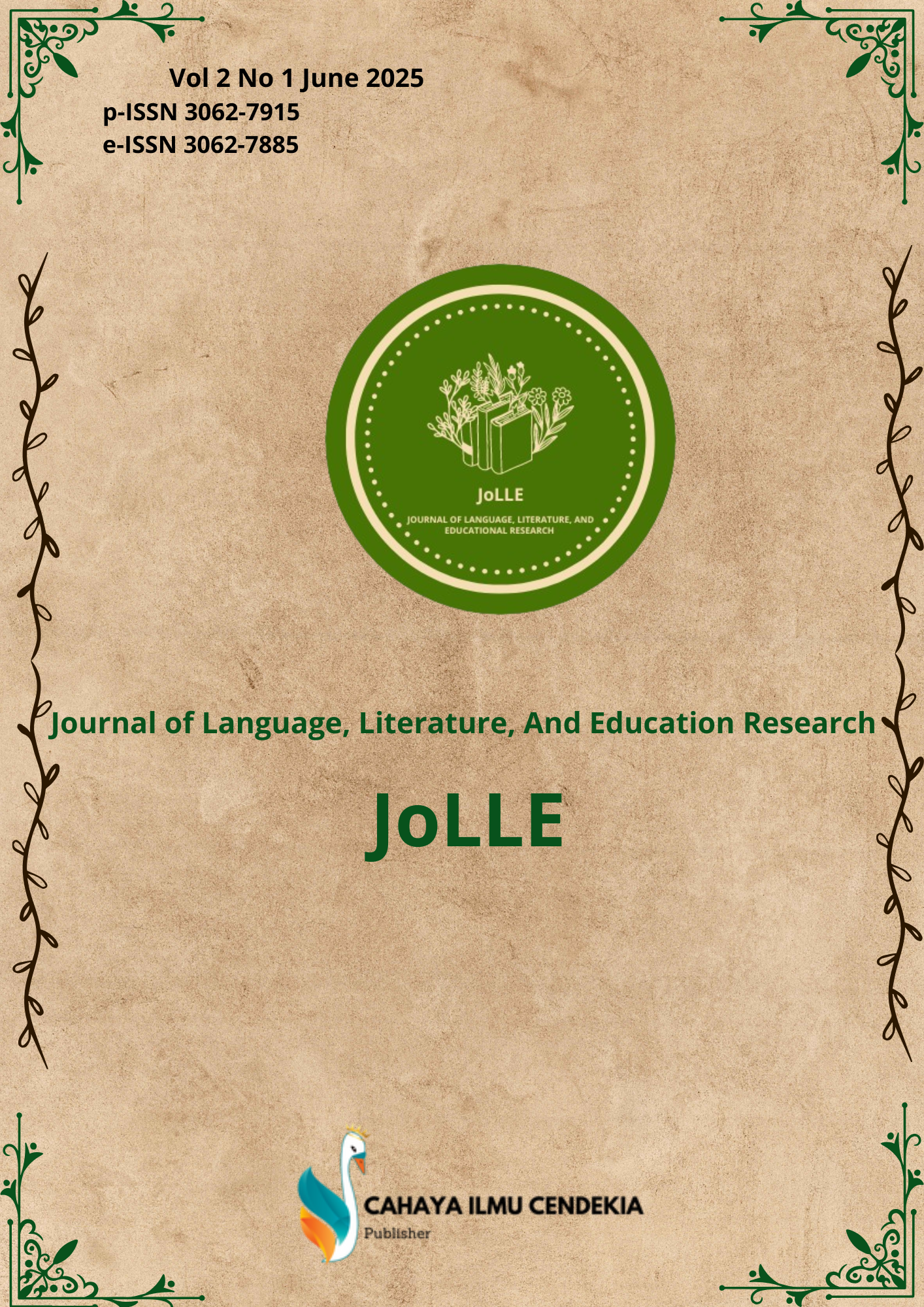Sociological Aspects Of Eyes In The Land Of Melus And Their Relevance To Indonesian Language Learning
Abstract
Purpose of the study: This study aims to describe the sociological aspects of literature contained in the novel Mata di Tanah Melus by Okky Madasari, its social functions, and its relevance to Indonesian language learning in Madrasah Tsanawiyah.
Methodology: This study used a qualitative descriptive method. Data were collected from the novel Mata di Tanah Melus and interviews with informants including educators and students. Data collection employed content analysis and in-depth interviews. Data were validated using source and theory triangulation, and analyzed using an interactive model and literary sociology approach based on Ian Watt's theory.
Main Findings: The study found socio-cultural aspects in the novel including knowledge systems, beliefs, kinship, tools and livelihood systems, and language. Social functions of the novel were reflected in positive reader responses indicating moral and educational value. The novel was also found to be relevant to Indonesian language learning, particularly in appreciation and review of literary texts aligned with the 2013 curriculum for Madrasah Tsanawiyah.
Novelty/Originality of this study: This study uniquely integrates literary sociology analysis with educational application by linking the socio-cultural content of a children's fantasy novel to curriculum-based Indonesian language instruction. It provides a model for using literary texts with cultural depth in character-building education at the junior secondary level.
References
D. Sulisworo and I. Safitri, “Online student-worksheet based on toulmin argumentation pattern in physics learning,” J. Phys. Conf. Ser., vol. 2394, no. 1, 2022, doi: 10.1088/1742-6596/2394/1/012033.
M. A. A. S. Faqih Ridwan Nafiul, “The use of wattpad as media in language learning strategy: teacher's and student's perspective of writing performance,” J. English Teach., vol. 8, no. 3, pp. 355–365, 2022, doi: 10.33541/jet.v8i3.3717 Abstract.
K. Leithwood, “A review of evidence about equitable school leadership,” Educ. Sci., vol. 11, no. 8, 2021, doi: 10.3390/educsci11080377.
M. R. Jiménez-Liso, L. López-Banet, and J. Dillon, “Changing how we teach acid-base chemistry: A proposal grounded in studies of the history and nature of science education,” Sci. Educ., vol. 29, no. 5, pp. 1291–1315, 2020, doi: 10.1007/s11191-020-00142-6.
H. Amalia, F. Abdullah, and A. S. Fatimah, “Teaching writing to junior high school students: A focus on challenges and solutions,” J. Lang. Linguist. Stud., vol. 17, no. 2, pp. 794–810, 2021, doi: 10.17263/jlls.904066.
A. Kangasharju, L. Ilomäki, M. Lakkala, and A. Toom, “Lower secondary students’ poetry writing with the AI-based Poetry Machine,” Comput. Educ. Artif. Intell., vol. 3, no. May 2021, 2022, doi: 10.1016/j.caeai.2022.100048.
P. A. C. Dinata, Rasidah, and V. W. Wardhana, “The validity of electronic practicum module based on scientific argumentation for practicum media during covid-19 pandemic,” J. Phys. Conf. Ser., vol. 1805, no. 1, 2021, doi: 10.1088/1742-6596/1805/1/012022.
B. Wróblewski and O. Petrenko, “Descriptive and inferential statistical analysis of expectations and needs of engineering students and graduates: A case study at the University of West Bohemia,” Lang. Learn. High. Educ., vol. 12, no. 2, pp. 477–494, 2022, doi: 10.1515/cercles-2022-2057.
S. Alharthi, “From instructed writing to free-writing: A study of EFL learners,” SAGE Open, vol. 11, no. 1, 2021, doi: 10.1177/21582440211007112.
K. Belousov, E. Erofeeva, T. Erofeeva, Y. Leshchenko, and N. Zelyanskaya, “University teachers of linguistics and self-image of their profession,” Procedia - Soc. Behav. Sci., vol. 214, no. June, pp. 667–676, 2015, doi: 10.1016/j.sbspro.2015.11.667.
R. H. U. Efrianto, Afnita, “The differences of students ’ ability in writing poetry through the use of constructivism learning method and modeling strategy,” Al-Ishlah J. Pendidik., vol. 16, pp. 4748–4761, 2024, doi: 10.35445/alishlah.v16i4.3342.
Y. K. Anastasiya Spaska, Halyna Kozub, Gulaim Abylasynova, Vladyslav Kozub, “Evaluation of innovative teaching methods using modern,” J. Ilm. Ilmu Terap. Univ. Jambi, vol. 9, no. 1, pp. 422–440, 2025, doi: 10.22437/jiituj.v9i1.38107.
J. F. Ruma, S. Akter, J. J. Laboni, and R. M. Rahman, “A deep learning classification model for Persian Hafez poetry based on the poet’s era,” Decis. Anal. J., vol. 4, no. August, p. 100111, 2022, doi: 10.1016/j.dajour.2022.100111.
Z. Seifoori and J. Fattahi, “The comparison of the method section of applied linguistics articles written by native and iranian writers in terms of grammatical complexity and clause types,” Procedia - Soc. Behav. Sci., vol. 98, pp. 1698–1705, 2014, doi: 10.1016/j.sbspro.2014.03.596.
Z. E. Attia, A. M. Gadallah, and H. M. Hefny, “An enhanced multi-view fuzzy information retrieval model based on linguistics,” IERI Procedia, vol. 7, pp. 90–95, 2014, doi: 10.1016/j.ieri.2014.08.015.
J. M.-H. Lim, J. M. Storey, S.-L. Chang, M. S. Esa, and S. A. Damit, “Preface: Multiple roles of language and linguistics in society,” Procedia - Soc. Behav. Sci., vol. 134, no. Iclalis 2013, pp. 1–2, 2014, doi: 10.1016/j.sbspro.2014.04.217.
L. Wang, “Designing and implementing outcome-based learning in a linguistics course: A case study in Hong Kong,” Procedia - Soc. Behav. Sci., vol. 12, pp. 9–18, 2011, doi: 10.1016/j.sbspro.2011.02.004.
A. V. Tsepilova and L. V. Mikhaleva, “Working with formulaic language as a way to evaluate and improve EFL non-linguistics students’ pragmatic skills in a culture-specific contextual situation,” Procedia - Soc. Behav. Sci., vol. 200, no. October, pp. 550–556, 2015, doi: 10.1016/j.sbspro.2015.08.022.
Y. Wang and J. Soler, “Investigating predatory publishing in political science: a corpus linguistics approach,” Appl. Corpus Linguist., vol. 1, no. 1, p. 100001, 2021, doi: 10.1016/j.acorp.2021.100001.
S. Pesina and T. Solonchak, “Concept in cognitive linguistics and biocognitive science,” Procedia - Soc. Behav. Sci., vol. 192, no. 3519, pp. 587–592, 2015, doi: 10.1016/j.sbspro.2015.06.100.
A. L. R. Schuster, N. L. Crossnohere, N. B. Campoamor, I. L. Hollin, and J. F. P. Bridges, “The rise of best-worst scaling for prioritization: A transdisciplinary literature review,” J. Choice Model., vol. 50, no. May 2023, p. 100466, 2024, doi: 10.1016/j.jocm.2023.100466.
N. V. Semenova and A. N. Sitsyna-Kudryavtseva, “About the term ‘dependent taxis’ in modern linguistics,” Procedia - Soc. Behav. Sci., vol. 200, no. October, pp. 149–156, 2015, doi: 10.1016/j.sbspro.2015.08.036.
M. Brooke, “‘Feminist’ in the sociology of sport: An analysis using legitimation code theory and corpus linguistics,” Ampersand, vol. 7, p. 100068, 2020, doi: 10.1016/j.amper.2020.100068.
M. Pikhart, “Human-computer interaction in foreign language learning applications: Applied linguistics viewpoint of mobile learning,” Procedia Comput. Sci., vol. 184, pp. 92–98, 2021, doi: 10.1016/j.procs.2021.03.123.
H. Van Pham, P. Moore, and B. Cong Cuong, “Applied picture fuzzy sets with knowledge reasoning and linguistics in clinical decision support system,” Neurosci. Informatics, vol. 2, no. 4, p. 100109, 2022, doi: 10.1016/j.neuri.2022.100109.
A. Schilling et al., “Analysis of continuous neuronal activity evoked by natural speech with computational corpus linguistics methods,” Lang. Cogn. Neurosci., vol. 36, no. 2, pp. 167–186, 2021, doi: 10.1080/23273798.2020.1803375.
D. Khairiah, S. Fatinah, J. Endardi, Nursyamsi, and D. Atmawati, “Genetic relationship between Kaili and Pamona languages: a historical comparative linguistics study,” Cogent Arts Humanit., vol. 11, no. 1, p., 2024, doi: 10.1080/23311983.2024.2409517.
M. Diko, “Harmonizing Africa’s linguistic symphony: navigating the complexities of translating African literature using a postcolonial theory,” Cogent Arts Humanit., vol. 11, no. 1, p., 2024, doi: 10.1080/23311983.2024.2411871.
R. Nhongo and L. Siziba, “Intellectualising African languages in literature and linguistics at selected Zimbabwean higher learning institutions,” South African J. African Lang., vol. 44, no. 3, pp. 223–230, 2024, doi: 10.1080/02572117.2024.2385262.
N. Soleimani and E. Mohammadkhah, “Meta-discourse markers in the book reviews published in ISI and non-ISI journals of applied linguistics,” Cogent Arts Humanit., vol. 7, no. 1, 2020, doi: 10.1080/23311983.2020.1807677.
L. Fontaine, “On prepositions and particles: A case for lexical representation in systemic functional linguistics,” Word, vol. 63, no. 2, pp. 115–135, 2017, doi: 10.1080/00437956.2017.1309029.
R. Alshalan and H. S. Alyousef, “Enhancing English–Arabic translator education through systemic functional linguistics: a study in a Saudi undergraduate classroom,” Saudi J. Lang. Stud., 2025, doi: 10.1108/sjls-09-2024-0054.
A. Q. Al Darwesh, “The representation of authorial and external voice in popular science book writing: a systemic functional linguistics approach,” Saudi J. Lang. Stud., vol. 5, no. 2, pp. 108–127, 2025, doi: 10.1108/sjls-08-2024-0043.
A. Sendra, E. Late, and S. Kumpulainen, “From data lifecycle to research activity model: research data management in data-intensive social sciences and humanities research,” Aslib J. Inf. Manag., 2025, doi: 10.1108/AJIM-12-2024-0959.
O. A. J. Mascarenhas, M. Thakur, and P. Kumar, “On assumptions, presumptions, suppositions, and presuppositions,” A Prim. Crit. Think. Bus. Ethics, pp. 223–253, 2024, doi: 10.1108/978-1-83753-346-620241008.
N. A. Nawawi and S.-H. Ting, “Interactional metadiscourse markers in political science and creative arts journal abstracts,” Saudi J. Lang. Stud., vol. 5, no. 2, pp. 76–90, 2025, doi: 10.1108/sjls-09-2024-0052.
K. Berglund, M. Bertilsson, U. Hermansson, M. Sager, E. Wikstrom, and G. Hensing, “Determinants of alcohol preventive actions by managers: a cross-sectional study among Swedish managers,” Int. J. Work. Heal. Manag., no. 220180, 2025, doi: 10.1108/IJWHM-12-2024-0258.
K. M. Al-Balushi, “Teaching english as discourse in Sultan Qaboos University,” Learn. Teach. High. Educ. Gulf Perspect., vol. 7, no. 1, pp. 30–41, 2010, doi: 10.18538/lthe.v7.n1.18.
A. H. Al-Hoorie and A. A. K. AlAwdah, “Transdisciplinary integration for applied linguistics: the case of electrophysiology,” Saudi J. Lang. Stud., vol. 4, no. 2, pp. 97–105, 2024, doi: 10.1108/sjls-06-2024-0028.
A. A. Zughaibi, “The barefoot shoemaker’s son: examining EFL teachers’ pragmatic competence in a Saudi context,” Saudi J. Lang. Stud., vol. 2, no. 2, pp. 68–83, 2022, doi: 10.1108/sjls-02-2022-0013.
H. A. Al Fadda, R. O. A. Haliem, H. S. Mahdi, and R. Alkhammash, “Undergraduates vs. postgraduates attitudes toward cooperative learning in online classes in different settings,” PSU Res. Rev., vol. 8, no. 3, pp. 577–591, 2024, doi: 10.1108/PRR-05-2022-0052.
M. M. Almirabi, “The morphology of the first-person Kana words,” Saudi J. Lang. Stud., vol. 5, no. 3, pp. 129–154, 2025, doi: 10.1108/sjls-07-2024-0038.
A. D’Andrea, G. Fusacchia, and A. D’Ulizia, “Linguistic insights, media mechanisms and role of AI in dissemination and impact of disinformation,” J. Information, Commun. Ethics Soc., 2025, doi: 10.1108/JICES-01-2025-0014.
H. Lotherington, M. Pegrum, K. Thumlert, B. Tomin, T. Boreland, and T. Pobuda, “Exploring opportunities for language immersion in the posthuman spectrum: lessons learned from digital agents,” Interact. Technol. Smart Educ., 2024, doi: 10.1108/ITSE-02-2024-0038.
E. Alhusaiyan, “A systematic review of current trends in artificial intelligence in foreign language learning,” Saudi J. Lang. Stud., vol. 5, no. 1, pp. 1–16, 2025, doi: 10.1108/sjls-07-2024-0039.
Copyright (c) 2025 Alfia Nurul Hidayah

This work is licensed under a Creative Commons Attribution 4.0 International License.
Authors who publish with this journal agree to the following terms:
- Authors retain copyright and acknowledge that the Journal of Language, Literature, and Educational Research is the first publisher licensed under a Creative Commons Attribution 4.0 International License.
- Authors are able to enter into separate, additional contractual arrangements for the non-exclusive distribution of the journal's published version of the work (e.g., post it to an institutional repository or publish it in a book), with an acknowledgment of its initial publication in this journal.
- Authors are permitted and encouraged to post their work online (e.g., in institutional repositories or on their website) prior to and during the submission process, as it can lead to productive exchanges and earlier and greater citation of published work.


1.png)

.png)
.png)







